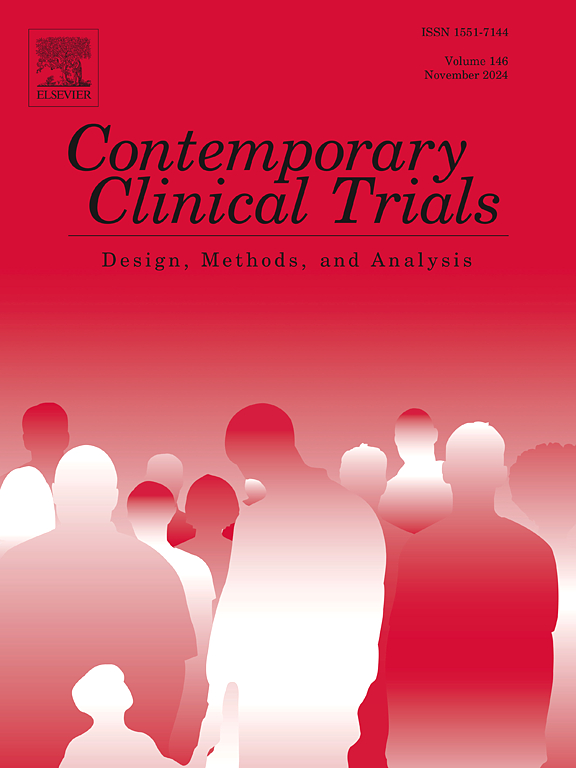在社会激励下增加活动的实施研究的设计和基线特征:STEP一起试验
IF 2
3区 医学
Q3 MEDICINE, RESEARCH & EXPERIMENTAL
引用次数: 0
摘要
背景:大多数美国人没有达到建议的运动量。即使是每天少量的增加也会对健康有益。在试点研究中,与社会激励相结合的可穿戴设备增加了每天的步数,但尚未在社区环境中进行长期有效性测试。本文描述了一项试验的研究设计和基线参与者特征,该试验测试了这些方法来增加费城地区家庭的身体活动。方法该试验被称为“STEP Together”,是一项混合1型有效性实施研究。参与者参加2-10人的家庭团队,其中至少有一名60岁或以上的人。每个参与者都会收到一个Fitbit设备,建立一个基线每日步数,并选择一个比基线高出1500到3000步的每日步数目标。家庭团队根据家庭规模分层,随机分配到控制、社会激励游戏化或通过慈善激励实现社会目标。参与为期18个月:12个月的干预和6个月的随访。结果随机抽取285个家庭小组779名参与者。由于2019冠状病毒病(COVID-19)大流行,招募工作比预期更加困难,而且已经参加体育活动的参与者人数高于预期,因此不符合条件。在不影响试验的潜在意图或概念基础的情况下,对资格标准的修改提高了招募的可行性。结论:这项研究的结果将为越来越多的证据提供可扩展的、有效的策略来激励个人和家庭增加他们的日常体育活动。临床试验注册号:NCT04942535本文章由计算机程序翻译,如有差异,请以英文原文为准。
Design and baseline characteristics of an implementation study to increase activity with social incentives: The STEP together trial
Background
The majority of people in the United States do not achieve recommended levels of physical activity. Even small, daily increases can have health benefits. Wearable devices paired with social incentives increased daily steps in pilot studies but have not been tested for long-term effectiveness in community settings. This paper describes the study design and baseline participant characteristics of a trial testing these approaches to increase physical activity among families in the Philadelphia area.
Methods
The trial, called STEP Together, is a Hybrid Type 1 effectiveness-implementation study. Participants enroll on family teams of 2–10 people, including at least one person 60 years old or older. Each participant receives a Fitbit device, establishes a baseline daily step count, and selects a daily step goal 1500 to 3000 steps greater than their baseline. Family teams are stratified based on family size and randomized to Control, Social Incentive Gamification, or Social Goals through Incentives to Charity. Participation is 18-months: a 12-month intervention and 6-month follow up.
Results
779 participants on 285 family teams were randomized. Recruitment was more difficult than anticipated due to the COVID-19 pandemic and higher-than expected numbers of participants who were already physically active and therefore ineligible. Changes to the eligibility criteria that did not impact the underlying intent or conceptual basis for the trial improved recruitment feasibility.
Conclusion
The results from this study will contribute to the growing body of evidence about scalable, effective strategies to motivate individuals and families to increase their daily physical activity.
Clinical trial registration number: NCT04942535
求助全文
通过发布文献求助,成功后即可免费获取论文全文。
去求助
来源期刊
CiteScore
3.70
自引率
4.50%
发文量
281
审稿时长
44 days
期刊介绍:
Contemporary Clinical Trials is an international peer reviewed journal that publishes manuscripts pertaining to all aspects of clinical trials, including, but not limited to, design, conduct, analysis, regulation and ethics. Manuscripts submitted should appeal to a readership drawn from disciplines including medicine, biostatistics, epidemiology, computer science, management science, behavioural science, pharmaceutical science, and bioethics. Full-length papers and short communications not exceeding 1,500 words, as well as systemic reviews of clinical trials and methodologies will be published. Perspectives/commentaries on current issues and the impact of clinical trials on the practice of medicine and health policy are also welcome.

 求助内容:
求助内容: 应助结果提醒方式:
应助结果提醒方式:


